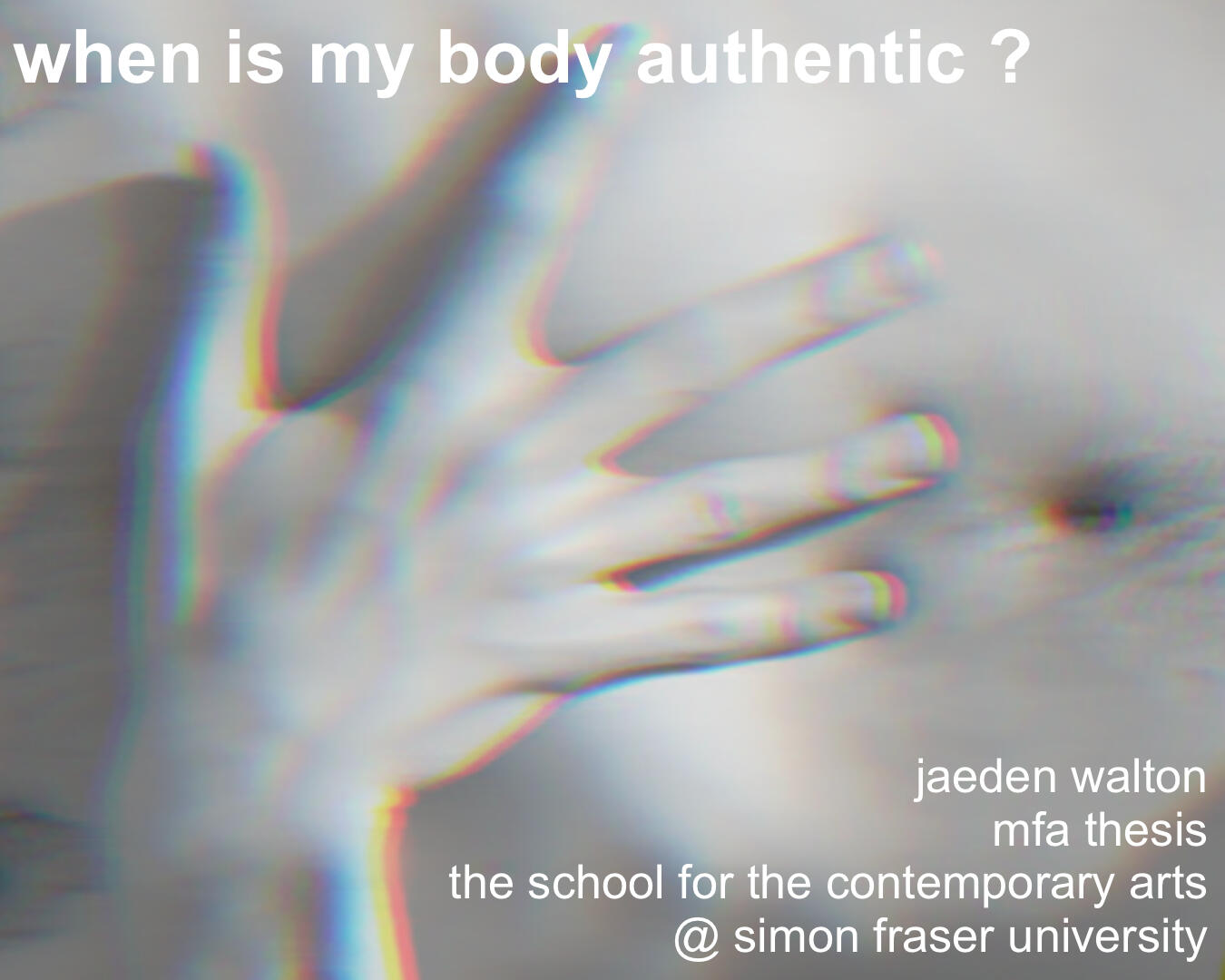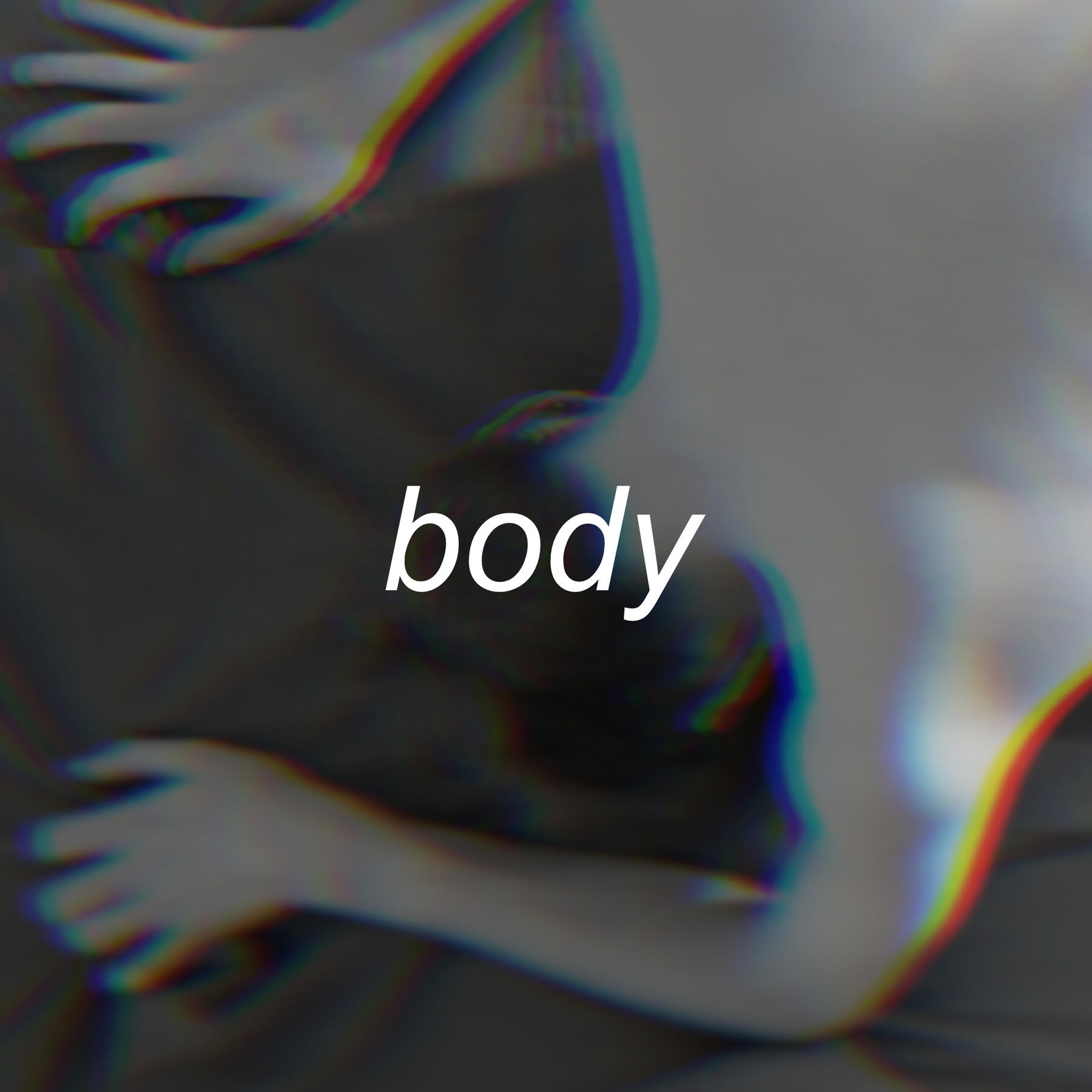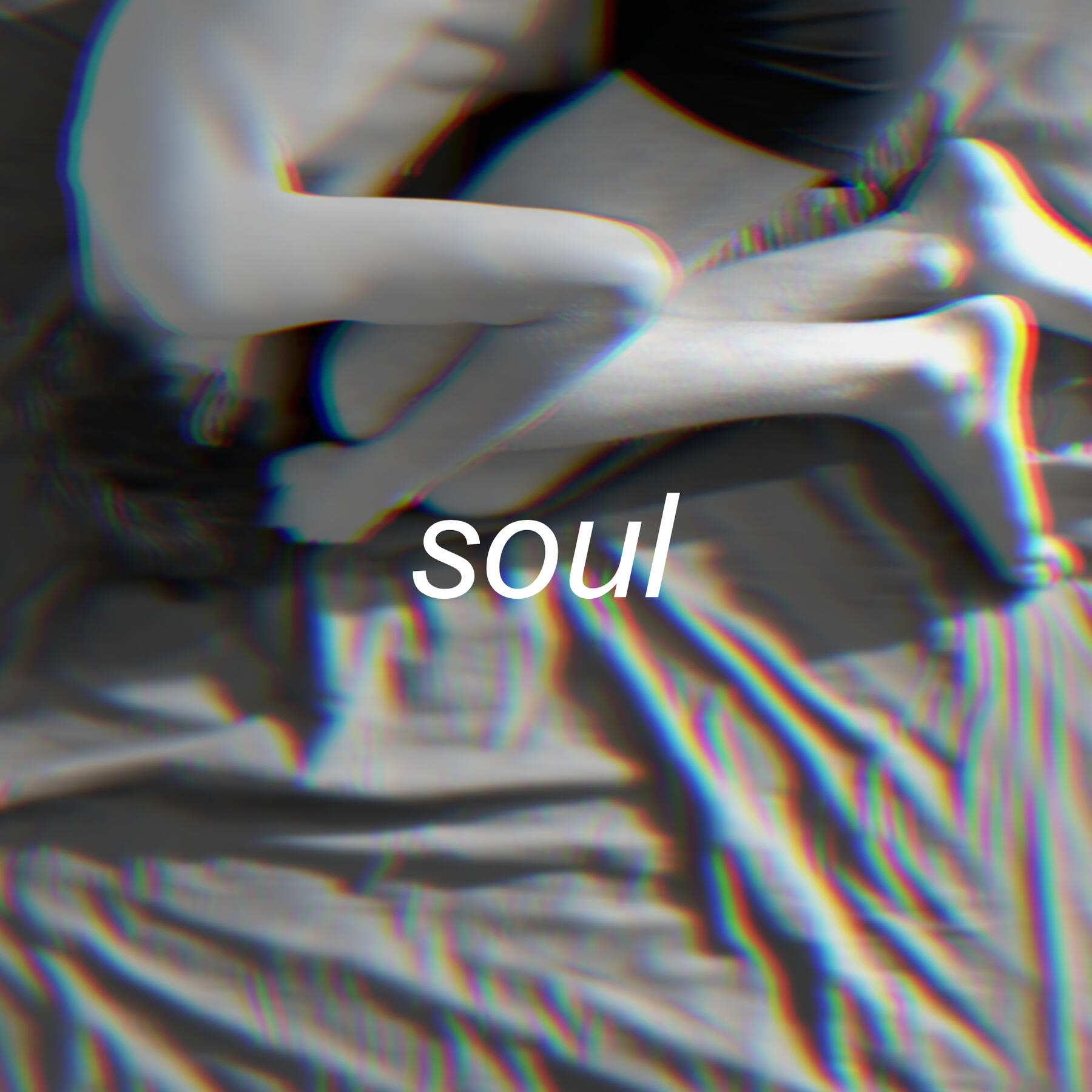
about the project
when is my body authentic ? is an interdisciplinary fashion runway show conceived by performing arts designer Jaeden Walton, MFA candidate at the School for the Contemporary Arts @ Simon Fraser University. This project is a key component of Walton's thesis defence and the completion of the MFA in Interdisciplinary Arts program. The project is scheduled for completion in the fall of 2026.The goal of the project is to challenge how performers carry a relationship between themselves and the daily performance they give, as well as challenge how what individuals carry with them (both literally and metaphorically) impacts our audience’s (the public) perceptions about our lives. By exploring these dynamics, the project challenges audiences to reconsider how they interpret the identities and lives of those they observe.when is my body authentic ? investigates the ways in which identity is performed, constructed, and perceived through scenographic tools such as costume, gesture, and stage design. It explores how appearance and movement shape public perception and interrogates how performance design can either (or both) reveal and/or subvert this process. Of particular interest is the fluid boundary between authenticity and performance, and how design interventions can affect the ways in which bodies are framed, staged, and made visible to others.[email protected]
the designer
Jaeden Walton is a performing arts designer based in Vancouver, originally from the land of the Syilx Okanagan peoples (Kelowna, BC).drawing heavy inspiration for their work in questioning the nature of how things operate, and how they can mould that into something new, jaeden strives to lure the spectator into a piece that seems ‘normal’ at first, to then expose them to something more radical and abstracted. rooted in canadian scenographic traditions, their work also spans international contexts, with design credits in the czech republic and new york city.Jaeden holds a BFA in Theatre Design with Distinction from the University of Victoria, and is currently taking their MFA in Interdisciplinary Arts at the School for the Contemporary Arts at Simon Fraser University.[email protected]
sshrc application '24
Title: When is my body a performance, and when is my body authentic?Current level of study & qualifications: I am in the first year of my MFA in Interdisciplinary Arts at the School for the Contemporary Arts at Simon Fraser University. I hold a BFA in Theatre Design from the University of Victoria, where I focussed my study of theatre in relation to national, political, celebrity, and personal identities.Project description: In our daily lives, we give a performance in the way we allow our bodies to appear. The performance we give is perceived by ourselves as well as the spectators of our daily lives. “A person builds an identity by being around other people, who in turn allow a person to distinguish personal aspects of their character” (Richardson 2018). How is scenography linked to personal identity or sense of self? Every physical body is uniquely its own. The way it is shaped, the way it moves, the lived experience it has, all elements together create a performance composed by the individual. Marvin Carlson claims that performance is highly socially-engaged, and is therefore blurred the boundaries of what performance is. (Carlson 2017) I will create a performative fashion runway which showcases the human body and its relationship to scenography which will question: When is my body a performance, and when is my body authentic? The goal of the project is to challenge how performers carry a relationship between themselves and the daily performance they give, as well as challenge how what individuals carry with them (both literally and metaphorically) impacts our audience’s perceptions about our lives. Each personal situation presents itself as a different performance, and “in each interaction people put on different identity” (Zaure 2023).Theoretical approach & method: I will create the runway through a devised process, building the world of the performance through the performer. This type of creation process will allow a personal connection between the performer and their garment. Each garment showcased on the runway will be individualized to the performer who is wearing it. The garment (or even lack of) will in some way accentuate the performance that each body gives, hoping to make the audience think about how they play a role in the performance of life. To individualize each outfit, the performers and I will engage in a devised process involving group meetings and exercises focussed on discovering parts of their body and mind that can be accentuated in a physical and material form. We will work together to create a symbolic garment that emerges from past personal experience, working with their individuality as a material, bringing it from the non-physical realm into the physical. My creation method will loosely follow that of the Estonian Academy of Art’s The Lab of Figurative Thought: You Only Have A Moment showcase at the 2023 Prague Quadrennial (Semper 2023), as well as the work shown in The Dress Series (Dempsey and Millan 1994). The runway will accompany a research paper exploring the different performer’s themes, and how their identities (as well as the audiences’) link to scenography.Contributions & significance: At present, there is little research exploring the links between scenography and personal identity, this research will develop an insight into that link, allowing other scenographers to examine the relationship further. The pursuit of this research aims to create a better understanding of people’s perception of performance and daily life. What aspects of each daily experience does one perceive as performance versus authenticity, and what parts of your own life are you fabricating to put a performance on for those around you?
Works Cited:
Carlson, Marvin. 2017. Performance: A Critical Introduction. Vol. Third edition. Milton Park, Abingdon, Oxon: Routledge. http://proxy.lib.sfu.ca/login?url=https://search.ebscohost.com/login.aspx?direct=true&db=nlebk&AN=1620915&site=ehost-live.
Dempsey, Shawna, and Lorri Millan. 1994. The Dress Series. http://www.shawnadempseyandlorrimillan.net.
Richardson, Vanessa. 2018. “Developing an Identity Through Theatre.” The Baseline (blog). December 14, 2018. https://medium.com/the-base-line/theatre-is-the-one-place-you-can-always-count-on-to-express-yourself-freely-and-without-judgement-17d80b975736.
Semper, Ene-Liis. 2023. Lab of Figurative Thought: You Have Only A Moment. Fashion Show.
Zaure, Franklinv Pyokpung. 2023. “Scenography and Identity Patterns in Design: A Performance Review of ‘The Meeting,’” January.
Selected Bibliography:
Goffman, Erving. 1978. Gender Advertisements.
Houlihan, Barry, and Grace Vroomen. 2021. “A Stage of Transition: Locating European
Identity, Culture and Memory at the Gate Theatre: Frank McGuinness’ ‘The Thrupenny Opera’ and Peer Gynt and Hugo Hamilton’s The Speckled People.” Review of Irish Studies in Europe 4 (1): 99–120. https://doi.org/10.32803/rise.v4i1.2634.
Janicka, Iwona. 2015. “Queering Girard—De-Freuding Butler: A Theoretical Encounter between Judith Butler’s Gender Performativity and René Girard’s Mimetic Theory.” Contagion (Greenville, N.C.) 22 (1): 43–64. https://doi.org/10.14321/contagion.22.1.0043.
Piqueux, Alexa. 2022. The Comic Body in Ancient Greek Theatre and Art, 440-320 BCE. 1st ed. Oxford Studies in Ancient Culture and Representation. Oxford: University Press, Incorporated. https://doi.org/10.1093/oso/9780192845542.001.0001.
Prague Quadrennial, dir. 2023. Costume Agency: Artistic Research.
https://www.youtube.com/watch?v=_06OECsHR-k.
Rixon, Tessa, Jennifer Irwin, David Walters, Jeremy Neideck, M’ck McKeague, Richard
Roberts, Anthony Brumpton, and Latai Taumoepeau. 2021. “Shaping Our Australian Scenographic Identities: A Visual Essay.” Scene 9 (1-2: Australian Scenography): 133–55. https://doi.org/10.1386/scene000413.
“The Presentation of Self in Everyday Life / Erving Goffman. - Simon Fraser University.”
n.d. Accessed November 21, 2024. https://sfu-primo.hosted.exlibrisgroup.com/primo-explore/fulldisplay?docid=01SFULALMA51421579390003611&context=L&vid=SFUL&lang=enUS&searchscope=defaultscope&adaptor=Local%20Search%20Engine&isFrbr=true&tab=default_tab&query=any,contains,erving%20goffman&sortby=date&facet=frbrgroupid,include,624915490&offset=0.
aesthetic research
flash warning for most of the videos, some links on this page may only be viewable on desktop
academic research
[etc] - SCA Grad Symposium
A thought that has little inkling of itself is a thought in the act, a thinking in the making of an occasion of experience. - Erin Manning ‘Against Method’ (61)Attention and attending differently; tending to the ruins and tracing the edges; shifting boundaries and fluctuating states—we gather to share research in progress, thoughts in the act, ideas both in and about flux, and also, and other things, and the rest, etc.The SCA 2025 Graduate Symposium brings together different forms of artistic and scholarly research, featuring work by MA and MFA cohort members Emma Best, Katie Belcher, Wyldie Bracewell, Alex Calcagno, Dom Chan, Liz Ellis, marcela oñate-trules, Christopher Outten, Taha Saraei, Jaeden Walton, and Boyu Xu. The evening will consist of 5-10 minute presentations by each scholar, followed by a short Q&A session.We acknowledge that this symposium is taking place on the traditional, ancestral, and occupied territories of the xwməθkwəy̓əm (Musqueam), Skwxwú7mesh (Squamish) and Səl̓ílwətaɬ (Tsleil-Waututh) peoples. We recognize the wisdom and survivance of our host nations, whose stewardship of the land has endured for millennia.The MA and MFA graduate students participating in this symposium hail from these lands and across Turtle Island, and from Australia, The Bahamas, Chile, China, Hong Kong, and Iran. Each of these origin points hold complex histories of imperialism and colonial violence. The continued impact of settler-colonialism on Indigenous ways of knowing (ecological, social, gender/sexuality, epistemologies, practice, and more) informs our experience as scholars and artists on these territories.
Performance: A Critcal Introduction
Carlson, Marvin. “The Performance/Performance Studies/Performativity Debate.” In Performance: A Critical Introduction, 1–20. 2nd ed. New York: Routledge, 2017.
Exploring the evolving definitions of performance, tracing its interdisciplinary roots across theatre, anthropology, linguistics, and sociology. Carlson distinguishes between performance as enacted behavior and performativity as the constitutive repetition of identity, highlighting their political and social implications. He argues that performance is not only a form of representation but also a powerful tool for challenging and reshaping cultural norms.
Signature Act
Davey, Maude. “‘Signature Act.’” Performance Research 29, no. 1 (January 2, 2024): 13–20. https://doi.org/10.1080/13528165.2024.2408108.
notes coming soon
The Struggle for the Nature of ‘Prejudice’: ‘Prejudice’ Expression as Identity Performance
Durrheim, Kevin, Mike Quayle, and John Dixon. “The Struggle for the Nature of ‘Prejudice’: ‘Prejudice’ Expression as Identity Performance.” Political Psychology 37, no. 1 (2016): 17–35. https://doi.org/10.1111/pops.12310
This article argues that prejudice is not just a fixed belief but a strategic identity performance shaped by context. It critiques traditional psychological models for overlooking how people actively define and contest what counts as “prejudice.” Through discourse analysis, the authors show how expressions of prejudice can construct norms, mobilize groups, and reshape social reality.
Theatre and Disbability
Kuppers, Petra. Theatre & Disability. New York: Palgrave Macmillan, 2014.
Kuppers redefines disability in performance as a creative and aesthetic force, emphasizing the importance of access, community, and alternative embodiment in theatre-making. Her work highlights how disability disrupts normative structures of time, form, and representation, offering new dramaturgical and design possibilities. This perspective is particularly relevant to scenographic approaches that center inclusive, identity-based expression and interrogate conventional ideas of presence, agency, and performative ability.
The Explicit Body in Performance
Schneider, Rebecca. The Explicit Body in Performance. New York: Routledge, 1997.
Schneider’s text provides a critical foundation for understanding the body as both a site of performance and political resistance. Analysis of feminist performance artists who use explicit corporeality (through means of nudity, bodily fluids, eroticism) as a mode of confronting dominant aesthetics and spectatorship offers essential tools for examining embodiment, visibility, and identity on stage. The exploration of the body as archive and as material expression directly informs inquiries into the blurred lines between authenticity and performance.
Disability and Contemporary Performance
Schneider, Rebecca. The Explicit Body in Performance. New York: Routledge, 1997.
notes coming soon
Samuel Beckett and Disability Performance
Simpson, Hannah. Samuel Beckett and Disability Performance. Palgrave Macmillan Ltd, 2022.
Simpson analyzes how Beckett’s representation of physical impairment intersects with contemporary disability performance, particularly through productions featuring disabled actors. The text challenges assumptions about textual fidelity and theatrical virtuosity, showing how disability performance can deepen and reframe canonical works. Her arguments support a broader reconsideration of bodily authenticity, limitation, and meaning in performance, particularly valuable in contexts where costumed embodiment and identity are the focal point.
Aesthetics of Pain, Fatigue, and Rest: Working Methods of Chronically Ill Artists within Disability-led Performances
Winter, Noa, Bernheimer, A W, and Avigad, L S. "Aesthetics of Pain, Fatigue, and Rest." Journal of Literary & Cultural Disability Studies 17, no. 2 (1976): 233-250. https://doi.org/10.3828/jlcds.2023.17
This scholarly article dismantles traditional, ableist representations of disability in the arts by spotlighting the complex, often silenced experiences of chronic pain, fatigue, and rest. Through analysis of contemporary performances grounded in lived experience and 'crip theory', it articulates an urgent call for anti-ableist, flexible, and representative practices in both art-making and arts institutions.
field research
Scenic & Sound Exploration | August 2025
scenic and sound designer for production of bruised fruit, hosted by surrey drama queens in surrey bc.
items of interest related to research:
- stories of chronic pain
- creating accessibility in the theatre
New York City Internship | May 2025
a one week trip to discover and explore within new york city. focussed on an internship at mio design nyc, located within in the garment district, under designer miodrag guberinic.
items of interest related to research:
- mio design nyc
- the met museum
- moma
- the garment district
- wicked
academic
mfa candidate Jaeden Waltongraduate supervisor Erika Latta
supervisory committee Wladimiro A. Woyno Rodriguezgraduate program chair Judy Radul
graduate program coordinator Samantha Diamond
sca director Peter Dickinson
performance
designer / director Jaeden Walton
land
This project was created on the unceded traditional territories of the Sḵwx̱wú7mesh Úxwumixw (Squamish), səlilwətaɬ (Tsleil-Waututh), and xʷməθkʷəy̓əm (Musqueam) Nations (colonially known as Vancouver), as well as the traditional and unceded territory of the Syilx Okanagan people (colonially known as Kelowna). We would like to thank these nations for their stewardship, care, and leadership on these lands.
oct 18, 2025
Vancouver, BCmind will focus on the inner perceptions of the self, how an individual person perceives their own being and how they project that perception outward through the way in which they hold themselves.Themes: Personality, personal perception, words and their matter, the subject in the mind, memory.Question: How do I perceive myself in my mind?

nov 1, 2025
Vancouver, BCbody will focus on the individual and their body, how one perceives their own body and how they perceive the bodies of those around them, both as individual entities and as a collective being.Themes: Body image, breath, body doubles, movements, outward representation, interaction, self-loath and confidence.Question: How does my body represent who I am in relation to other bodies it interacts with?

nov 15, 2025
Vancouver, BCsoul will focus on the inner feelings of the self, the core of the being in its true authentic forms free from perception, and how each individual mind/body/soul is connected to one another in the grand scheme of the universe.Themes: Spirituality, connectedness, inner-self, authentic form, values, core-being, the universe, loss.Question: How is my inner-person connected to the universe?

we'll be connected soon...







